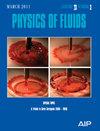Machine learning methods for turbulence modeling in subsonic flows around airfoils
IF 4.3
2区 工程技术
Q1 MECHANICS
引用次数: 202
Abstract
Reynolds-Averaged Navier-Stokes(RANS) method will still play a vital role in the following several decade in aerospace engineering. Although RANS models are widely used, empiricism and large discrepancies between models reduce the reliability of simulating complex flows. Therefore, in recent years, data-driven turbulence model has aroused widespread concern in fluid mechanics. Based on the experimental/numerical simulation results, this approach aims to modify or construct the turbulence model for specific purposes by machine learning technologies. In this paper, we take the results calculated by SA model as training data. Different from low Reynolds number turbulent flows, the data from high Reynolds number flows shows an apparent scaling effect, thus leading to difficulties in the data-driven modeling. In order to improve the fitting accuracy, we divided the flow field into near-wall region, wake region, and far-field region, and built individual model for every region. In this paper, we adopted the radial basis function neural network (RBFNN) and some auxiliary optimization algorithms to reconstruct a mapping function between mean variables and the eddy viscosity. Since this model reflects the relationship between local flow characteristics and turbulent eddy viscosity, it is independent on the airfoil shape and flow condition. The training data in this paper is generated from only three subsonic flow calculations of NACA0012 airfoil. By coupling the proposed approach with N-S equations, we calculated various flow cases as well as two different airfoils and showed the eddy viscosity contours, velocity profiles along the normal direction of wall and skin friction coefficient distributions, etc. Compared with the SA model, the results show a reasonable accuracy and better efficiency, which indicates the positive prospect of data-driven methods in turbulence modeling.围绕翼型的亚音速湍流模型的机器学习方法
reynolds - average Navier-Stokes(RANS)方法在未来几十年仍将在航空航天工程中发挥重要作用。尽管RANS模型被广泛使用,但经验主义和模型之间的巨大差异降低了模拟复杂流动的可靠性。因此,近年来数据驱动湍流模型引起了流体力学领域的广泛关注。该方法基于实验/数值模拟结果,旨在通过机器学习技术修改或构建特定目的的湍流模型。本文将SA模型计算的结果作为训练数据。与低雷诺数湍流不同,高雷诺数湍流的数据表现出明显的尺度效应,导致数据驱动建模困难。为了提高拟合精度,我们将流场划分为近壁区、尾迹区和远场区,并对每个区域建立了单独的模型。在本文中,我们采用径向基函数神经网络(RBFNN)和一些辅助优化算法来重建平均变量与涡流粘度之间的映射函数。由于该模型反映了局部流动特性与湍流涡流粘度之间的关系,因此不受翼型形状和流动条件的影响。本文的训练数据仅由NACA0012翼型的三次亚音速流动计算生成。将该方法与N-S方程相结合,计算了两种不同翼型的不同流动情况,得到了涡动黏度轮廓、沿壁面法向的速度分布和表面摩擦系数分布等。结果表明,与SA模型相比,该方法精度合理,效率更高,表明数据驱动方法在湍流建模中具有良好的应用前景。
本文章由计算机程序翻译,如有差异,请以英文原文为准。
求助全文
约1分钟内获得全文
求助全文
来源期刊

Physics of Fluids
物理-力学
CiteScore
6.50
自引率
41.30%
发文量
2063
审稿时长
2.6 months
期刊介绍:
Physics of Fluids (PoF) is a preeminent journal devoted to publishing original theoretical, computational, and experimental contributions to the understanding of the dynamics of gases, liquids, and complex or multiphase fluids. Topics published in PoF are diverse and reflect the most important subjects in fluid dynamics, including, but not limited to:
-Acoustics
-Aerospace and aeronautical flow
-Astrophysical flow
-Biofluid mechanics
-Cavitation and cavitating flows
-Combustion flows
-Complex fluids
-Compressible flow
-Computational fluid dynamics
-Contact lines
-Continuum mechanics
-Convection
-Cryogenic flow
-Droplets
-Electrical and magnetic effects in fluid flow
-Foam, bubble, and film mechanics
-Flow control
-Flow instability and transition
-Flow orientation and anisotropy
-Flows with other transport phenomena
-Flows with complex boundary conditions
-Flow visualization
-Fluid mechanics
-Fluid physical properties
-Fluid–structure interactions
-Free surface flows
-Geophysical flow
-Interfacial flow
-Knudsen flow
-Laminar flow
-Liquid crystals
-Mathematics of fluids
-Micro- and nanofluid mechanics
-Mixing
-Molecular theory
-Nanofluidics
-Particulate, multiphase, and granular flow
-Processing flows
-Relativistic fluid mechanics
-Rotating flows
-Shock wave phenomena
-Soft matter
-Stratified flows
-Supercritical fluids
-Superfluidity
-Thermodynamics of flow systems
-Transonic flow
-Turbulent flow
-Viscous and non-Newtonian flow
-Viscoelasticity
-Vortex dynamics
-Waves
 求助内容:
求助内容: 应助结果提醒方式:
应助结果提醒方式:


